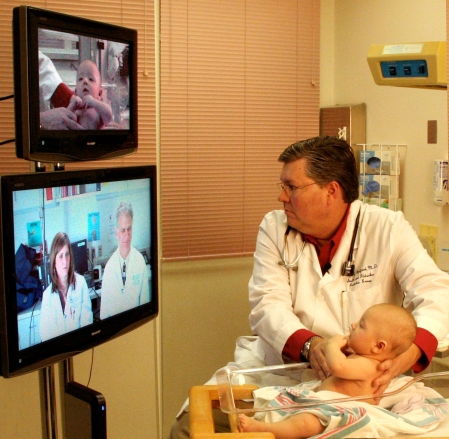Online cameras add to hospitals new medical tools
Yesterday, the intensive care unit at Mercy Medical Center had miniature cameras installed on the ceiling in 12 ICU patient rooms. Nurses on the floor called them ”another set of eyes”. The pictures taken from a camera give another tool to hospital-bound doctors with special training in the treatment of critically ill patients, also called intensivists, in the growing practice of “telemedicine.” Gastric Bypass surgery, on the other hand, is one of many surgeries that will have to be done in person for some time.

Telemedicine on babies
More and more hospitals are adding technology, such as the Sisters of Mercy in St. Louis, Mercy’s parent company, to maximize their in-house resources. The use of remote technology in intensive care units “is probably one of the newest and fastest areas in telemedicine,” said Jonathan Linkous, chief executive officer of the American Telemedicine Association in Washington.
For the past few years, hospitals have turned to their intensive care units to help save costs and improve access to resources such as the intensivist, Linkous said. If you look at the budget of a hospital the intensive care unit is always the highest cost one.
The general medical industry has come to employ more intensivist-trained doctors since numerous studies have shown that these caregivers can improve the quality of care for critically ill patients and their survivability.
That’s “if you have one available,” Linkous said. “A lot of hospitals in remote locations don’t have intensivists.”
Telemedicine helps bridge that specialty doctor gap, especially among health systems with hospitals in less urban environments. More than 60 medical specialty doctors and subspecialists have used telemedicine, the association reports. The origin of the telemedicine movement can be traced back about 40 years to applications such as transmitting X-rays across phone lines, Linkous said. Now, telemedicine is becoming an accepted diagnostic tool. Rarely to be people trasmit images using the iPhone. Even though CSI gives the imporessions that forensic scientists take pictures of fingerprints on their Apple iPhone and send them to the lab, this doesn’t really happen yet.
“Pretty soon we’re not going to think a thing about going to a hospital that uses telemedicine,” Linkous said. “I’m confident the concept is going to catch on at a rate similar to the adoption of automated teller machines in the banking industry decades ago. “
In Arkansas, telemedicine has been used to treat premature births and intensive care patients. Telemedicine has been conducted through the University of Arkansas for Medical Sciences in Little Rock, Arkansas’ only teaching hospital and it’s affiliated with a children’s hospital, as well as through Baptist Health Medical Center in Little Rock. A great way to offer expert care and cut costs.
Linkous said the expansion of electronic ICUs has been in tandem with the growth of intensivists.
About 35 hospitals nationwide have electronic intensive care units, according to a Baltimorebased technology company called VISICU Inc.
In a demonstration Wednesday, a faint doorbell sound clued an ill patient that “back-up” care was summoned. A friendly female voice gave further identification about the technology that can allow health systems to maximize their information technology infrastructure.
Deibert fiddled with the onscreen prompts to improve the image of the patient and her caregiver in an ICU room.
Flat-panel computer monitors stacked three across and two deep in the break room at the 200-bed Catholic hospital were a duplication of a set-up 340 miles away in St. Louis, she said.
Other monitors showed the “real-time” patient vital information such as blood pressure, pulse and respiration.
Nightshift ICU nurses typically use SafeWatch more frequently than the day-shift nurses because doctors are harder to find in the middle of the night, said Carla Terrell, the director of Mercy Medical Center’s ICU.
SafeWatch can help caregivers in many ways, from actual intervention with the care of a distressed patient to electronic charting duties, she said.
In a recent example, a Mercy specialist needed the help of an intensivist in St. Louis, Terrell said, “and there were two physicians present. One here and one in St. Louis.”
The future of telemedicine is bright and we will look forward to it’s numerous advances.
No comments:
Post a Comment